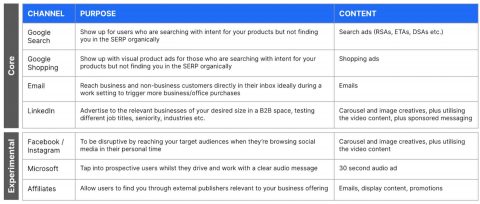Consumers around the world spend an average of 7.5 hours per day consuming media, both traditional and digital. American consumers tend to average more time than most – over 12 hours per day – highlighting the importance that media plays as a major part of their daily lives.
But in order to get the most out of media, you have to plan. As an essential part of marketing, good media planning requires a solid understanding of both digital and traditional media, and which platforms specifically will be the best at delivering a brand’s content to the right audience in order to support and achieve their sales and marketing objectives. An effective media strategy will ensure the most efficient use of your time and money, whilst ensuring the best results. Not sure where to start? Here’s our guide to media planning.
An effective media strategy will ensure the most efficient use of your time and money, whilst ensuring the best results. Not sure where to start? Here’s our guide to media planning.
What is media planning?
Media planning, put simply, is deciding how, when, where and why your brand advertises content to your target audience. Media planning determines the media spend necessary to make campaigns successful, the content you need to promote and the channels on which you push this content in order to generate the best results for your business.
Media planning links heavily to paid media, as it often involves media spend for paid promotion. However, it’s important to factor in owned and earned media into the planning too.
Owned media
Owned media consists of a brand’s owned original assets, such as blog posts and organic videos, published directly on platforms owned and operated by the brand themself, such as their YouTube channel or their website.
Nailing your owned media is really beneficial because it doesn’t entail any ad spend.
Earned media
Earned media includes assets that share your organisation’s message but are created by external content creators, such as news publishers, influencers or people leaving reviews for your business.
What does a media planner do?
It’s a media planner’s job to identify which media platforms will best advertise a brand’s product or service to its target audience, as well as ensuring all owned and earned media is working well for the brand’s objectives, keeping consistency across all channels.
There may be channels that media planners run directly or some that require liaising with partner buying agencies. This could mean you oversee a Google Ads campaign in one instance or you’re responsible for organising an Out of Home advertising strategy with a billboard provider in another instance.
Example of media distribution for a client’s brand campaign:
Developing a media plan
It starts with research
As with all good digital marketing, the tactics you plan to implement should always feed into your objectives, and your objectives should always be determined based on research. Without decent market research, you’re left to make assumptions about your audience which may be entirely inaccurate.
Without decent market research, you’re left to make assumptions about your audience which may be entirely inaccurate.
You can’t build a successful marketing strategy based on guesswork. A successful marketing strategy revolves around what your customer needs, not what you, as a marketer, think they want.
The bigger picture
Creating a media plan should go hand-in-hand with your wider marketing strategy and a good marketing strategy should lay all the right foundations for successful media planning to take place.
Marketing strategy should consist of market orientation and research, followed by audience segmentation, choosing your target segments and then how you position your brand to each.
From here, you can determine your objectives and your integrated marketing communications plan, in which a media planning strategy plays a huge part.
Media planning process
Here are some key considerations for your media planning:
- Research – find out as much as possible about your customers, your market, your previous performance and your competitors to make sure research and data steers the decisions you make for your brand.
- Audience – who are you targeting with your message and how is this message serving them?
- Objectives – what action are you looking for your audience to take and what KPIs will this impact for your brand?
- Budgets – how much budget is necessary to meet the objectives set for your campaign?
- Reach – how will you reach your target audience with the necessary message? Which networks will you use?
- Creative – how will you capture the attention of your audience with creatives and messaging that cut through the noise
- Measurement – how will you measure the success of media campaigns and report on this?
An effective media plan process we have done for a client recently:
What makes good media planning?
Both traditional and digital media are important to good media planning. Having a good grasp on what is available for both, not allowing the two to exist in silos and, instead, integrating all activity is necessary for the best results.
From an owned and earned perspective, media planners can lean on those in SEO, content marketing, social media and digital PR to distribute content.
From a paid perspective, it is the job of the media buyer to:
- Recommend the right paid advertising options
- Buy ad space for campaigns
- Negotiate rates for content distribution
- Work with the content team to ensure all brand guidelines are met
- Distribute and monitor the budget for paid marketing campaigns
- Conduct campaign analysis to ensure cost efficiency
Benefits of media strategy for the wider business
Media planners and strategists can bring a lot of knowledge and expertise to benefit the wider business.
- Your campaigns allow you to get to know your target audience’s behaviours on a deeper level which can feed into and improve your marketing strategy going forwards
- It allows you to know what creative content resonates best with your audience
- You can stay on top of the latest media trends and technology and share this with the wider business
- Budget management is a core business skill that feeds into many other areas
- Conducting analyses to measure the success of your media planning process unveils useful insights you may not otherwise know about your business and industry
Media planning vs media buying
Now we have addressed media planning on the whole, it’s good to make sense of what is meant by media buying and how that fits into things.
Media buying is the purchase of advertising from a media company such as a television station, local newspapers, magazine, blog or website. It also entails the negotiation for price and placement of ads, as well as research into the best new venues for ad placement.
Media buying typically falls on the paid media department. Google Ads is often the core platform when it comes to paid media and digital ad spending for brands.
However, paid media can cover any platform where brands can spend money. Where you choose to invest media spend depends entirely on your business objectives, audience and budgets.
A unified approach
Media planning at Hallam relies on a unified approach between all service lines.
For example, there would be no point in running a campaign if the technical tracking wasn’t implemented properly, nor would it be worthwhile to launch a campaign without the right level of creative research and input beforehand.
Similarly, you wouldn’t have ad creatives clash with the organic work on a company’s website.
Don’t let ‘plan’ become a 4-letter word. We’ve got dedicated media strategists at Hallam who can help with your media planning needs. Get in touch today.






